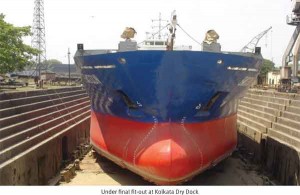With time and sustained operations in heavy weather, the paint film develops micro fine cracks allowing seawater the access it seeks. Since the exposed steel surface is not homogenous, electro potential differentials exists leading to corrosion and loss of strength.
A target life beyond twenty years cannot be achieved using the old methods of design and maintenance. It requires a new mind set. The life cycle costs of a ship are a result of decisions made at the design stage.
These costs can be grouped as visible and invisible. The invisible costs are manifest only after the ship has been built. They arise due to complexity, precision, variability in outcomes, over sensitivity, immature technology, omitted health and environmental hazards, short life spans, and excess demand of operational skills. The invisible costs due to these factors can only be quantified by experienced staff and are fairly substantial. Hence, increasing target life is a very intricate tasking that involves close review and update of the existing practices. Unlike Machinery and Equipment which can and may be fully replaced during a Half-life modernization, the Hull cannot be changed. The design and subsequent preservation of the hull are thus key elements which affect the life of the ship as a whole. The rest of this submission will discuss how this life extension can be achieved.
Corrosion Control: Corrosion control at the design stage has in the past generally been accorded little priority. The optimization of structural weight using closed spaced stiffeners with light weight plating results in hungry horse looking structures. Such designs being more elastic initially have a superior shock response. However with time, the strength of these thin plate hulls will degrade faster with corrosion which is inevitable. A light weight hull is more prone to fatigue cracks both in the preserving paint film and the joining welds. With time and sustained operations in heavy weather, the paint film develops micro fine cracks allowing seawater the access it seeks. Since the exposed steel surface is not homogenous, electro potential differentials exists leading to corrosion and loss of strength. The process is self-sustaining if not interrupted. For longer life, a stiffer hull using wider spaced stiffeners and thicker plating incorporating a small accidental corrosion allowance is far better. The resultant penalty on power and fuel is more than offset by the longevity gained.
At the design stage, the influence of long term corrosion and its correlation to the Hull strength is often overlooked due to limited data and expectations. Nevertheless, the reduction of structural weight still remains a dogmatic priority of many designers. Detailing shell structures for longevity requires special effort. Many junior civilian design staff responsible for such work, being far from the sea, are indifferent to the unrelenting electro chemistry that can send a ship to its grave prematurely. Corrosion the silent killer depends on water. Every effort to reduce the electrode and the electrolyte is necessary. The preparation, Paint schemes; passive and active cathodic protection for the surfaces in each compartment need to be very carefully examined. Humidity control using increased ventilation and De-humidifiers in wet/moist spaces are absolutely necessary to avoid condensation and contamination of Insulation. The drainage slope, scupper, downspout, and suction locations need careful review and quality assurance (Q.A) at the design stage using 3-D graphic simulators. As part of the pre painting preparation, all horizontal surfaces of stiffeners, openings and drainage ports that may retain water need to be rounded off after erection and pre lined during painting prep. A tedious task that is more often not done.Construction and Maintenance: If longevity is to be achieved, the Q.A standards of warship hull manufacture and repairs which includes survey, repair, prep and paint needs a massive overhaul. The current technology used is very deficient and is compounded by poor tooling, staging, lighting, ventilation, humidity control and lack of appropriate machinery and personnel. Poorly educated laborers, painters, fitters and platers form the bulk of the construction department trades. Ships and submarines are built with high strength steels which are expensive. During maintenance, corroded surfaces have to be stripped off paint and prepared for repainting. Very often, freshly sharpened, hardened steel chipping hammers have been used to do this. This leaves a set of notch indentations on the steel surface which reduces the strength of the original plate. The net result is a surreptitious and unplanned degradation of Hull strength which has never been documented or accounted for.
The training, education and compensation of the hull trades and junior hull design staff have long been neglected. There is a technology gap in as much the average worker has little or no formal technical training whilst his departmental head needs a Master Of Science Degree and more. Many of the older generation of hull workers do not even have a high school diploma. Such a wide and heavily skewed spectrum of qualifications within a Department can never guarantee an extended hull life. Based on the savings to be gained, it will pay off handsomely if the construction departments are fully modernized and the compensation packages re-engineered to meet the desired goals and standards required. The use of cameras, real time computerized media recording, detail work process standards and visual training documentaries are seriously lacking. Most yards do not have a set of detail process videos detailing the various jobs step by step including appropriate tools and equipment, electronic documentation of the Q.A, Q.C standards, atmospheric controls, the monitoring equipment required and the expected productivity norms. Modern 2 coat epoxies require SA 3 prep, sponge blasting, ultra clean vacuums/wash and spot infra-red dryers.
As terrorists get more sophisticated, they will endeavor to use the sea route to move fissile materials and “dirty devices” into maritime countries clandestinely using container bound shipments.
Preparation and pre-lining of weld lines and contoured surfaces at site referred to earlier also deserves special attention. During construction, the integrity of the Module during handling, erection, welding and house-keeping must be continuously verified and recorded by qualified Technologists to ensure the integrity of the paint film, the design dimensions and layout. The cost of careful design with proper regular high performance maintenance and planned half life refits to extend the serviceable life of a hull is small compared to the costs of building a new ship.
In lieu of repair at site, “repair by replacement” and subcontract through joint partnership with the Private sector have not made much headway. Though such competitive practices reduce costs, Public and quasi public sector, unions and management, all being stakeholders, are usually unresponsive to outsourcing since it limits their growth and monopoly. Maintenance costs and down time can be considerably reduced if alternate competitive repair options are permitted and are a part of the pre-planning process. Life raft repair and maintenance is just one of such examples.
Like naval ships, all merchant ships are required to carry a set of identical Lifesaving gear under identical regulations. In times of peace, merchant fleets have a much higher operational availability and are subject to more intense economic competition, than Naval ships. Yet, the owners of merchant ships, who can afford less downtime and costs, entrust the Maintenance of their Life saving gear entirely to the Private sector. On the other hand, some Navies have insisted on expanding their owns hop facilities in the Public sector for identical work. There is little justification for that choice. An independent audit to establish the maintenance work that could be done by joint partnership between the two sectors would go a long way in reducing costs and improving operational availability.
Fire & Nuclear risk: A sustained fire on board any ship will seriously degrade the hull. Since this risk cannot be eliminated entirely, it must be carefully monitored and reduced. The need of an electronic Fire and Inflammable& Hazard (FIH) statement that lists the types, quantities and combustion end products of every flammable and nuclear Hazards on board every warship and Submarine at any instant is necessary. No Command can afford to be indifferent to such basic precautions. A guarantee of a long life span necessitates that the risk of a fire and consequential loss of strength is controlled. To achieve that, the electronic FIH statement should be kept up-to date whenever the agreed ceiling change limits have been reached. A copy should be handy and available in the Command, the Repair Yard when a ship is taken in for repairs and outside Fire fighting agencies when summoned for assistance. The Design Office has to be the initial originator for the FIH but maintenance thereafter should be the entrusted to the Ship and Command.







I have found this articles highly invaluable and will like to discuss my project with the author. I am currently a student at National Defence College in Nigeria and my topic is Navy Dockyard and Technology Asset Development: An Appraisal. Your input on this will be highly appreciated. Capt Pwol